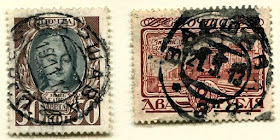Specializing in Poland’s stamp requires patience as
well as a good grasp of European geography and political history. Where and
what Poland currently is, as reflected in the above map, only remotely
corresponds to the several “Polands” encompassed by Scott International Part
1, 1840-1940 (aka Big Blue, or BB). A better map for Big Blue lovers, such
as the one drawn by Gerben VanGelder (below), will show the many machinations
that kept changing Poland’s borders during the classical stamp era. This
volatility must have caused headaches for BB’s editors and led them to scatter
Poland-related stamps throughout the album.
At minimum, Poland philately must consider stamps
related to Allenstein (Oltztyn), Silesia, Danzig (Gdańsk), Prussia, Austria,
Russia, Germany, Lithuania, Memel, Ukraine, Marienwereder and, of course, the
various occupation stamps. Guided by VanGelder’s helpful map, this post will
sketch the labyrinth of Poland’s stamps, 1860-1940, using scans of stamps
collected in Bud’s Big Blue.
Although Poland’s postal system dates to 1558, the
first identifiable Polish stamp appeared in 1860. Issued by the Congress
Kingdom of Poland (dark green on VanGelder’s map), a political entity
established in 1815 and controlled by Russia Czars, it was used solely for mail
within Poland and to Russia. The design reflects its Russian heritage with the
Kingdom’s arms at the center. These, not being formally approved by Russian
authorities, were withdrawn in 1865, after which Russian stamps were used
throughout Poland until 1918.
At first, Russian stamps used in Poland were canceled with both languages in the inscription, but after 1871, only Russian. The examples show below were canceled in Warsaw (ВАРШАВА), both in 1913. Such cancels frequently pop up in feeder albums.
Similarly, Polish city cancels can be found on early
Austrian stamps. From the late 18th century when independent Polish
territory was divided among Austria, Russia and German states, postal service
was controlled by outsiders. The late 19th Austrian century examples
shown below were canceled in Kraków and Ustron, a health resort town in southwest
Poland (Cieszyn Silesia).
These may have been Austrian field post offices.
The redefinition of Poland’s boundaries following
World War I stirred yet another philatelic whirlwind. US President Woodrow
Wilson supported the notion that cultural groups should be able to govern their
own homelands. After the war, he favored Poland becoming an independent state.
The light green area on VanGelder’s map shows the result. Some parts of ancient
Poland – Upper Silesia, Allenstein, and Marienwerder -- were allowed to choose
by a vote (plebiscite) either Poland or Germany as a homeland. VanGelder marks
these areas in red. All three opted for Germany; all three issued stamps; all
three are represented in BB.
At the time, Poland very much wanted Gdansk (Danzig)
within their border, but that was not to be. It became an unaligned, free city.
Memel was attached to Lithuania. BB has large sections for both Danzig and
Memel although, by 1938, Poland issued stamps for its offices in Danzig (BB
places four of these in Poland’s BoB section).
At the War’s end, a jubilant Poland issued its first ever stamps as an independent nation. These began with four overprinted local stamps and some twice overprinted occupation stamps that Germany had hastily issued when they invaded Poland at the War’s outset. BB divides the occupation stamps between the Germany and Poland BoB sections. However, the twice overprinted variety with the blackened German inscriptions merit a place in the Poland section proper (1918).
Poland also overprinted some leftover Austrian stamps, but BB includes none of these.
From 1919 thru 1925, Poland’s stamps celebrate newfound independence and ancient heritages. The traditional Polish eagle predominates. Peace breaks out like brilliant sunshine. Ordinary citizens ride stallions, sow seeds, reap crops, and mine coal. Historic notables – Copernicus and Konarski – are commemorated. Only a few politicians and contemporary leaders, such as Marshal Pilsudski (1919) and President Wojciechowski (1924), appear.
These themes faded after
May 1926 when Marshal Pilsudski carried out a successful coup d’état that ended
the democratically elected government of President Wojciechowski. Piłsudski,
hoping to restore “moral fitness,” supported Ignacy Mościcki as the new
president and replaced the old constitution with one more to his liking. The
philatelic upshot is more political leaders on stamps, particularly Piłsudski
and Mościcki. Military themes come to the fore, including appreciation for
George Washington and Poland’s role in US independence.
Piłsudski’s influence on
Polish stamp designs continues beyond his death (1935) and into those issued
for the Polish Government in Exile during World War II. Spaces for the exile
stamps are included in Part II of Scott International.
Part I, however, ends its Poland section with German stamps overprinted for yet
another siege of occupation.
Poland’s expanded
frontiers, as illustrated by the map at the top of this blog post, resulted
largely from peace negotiations following World War II. Marienwerder is now Kwidzyn,
Allenstein is Olsztyn, Danzig is Gdańsk, Silesia is Katowice – all in Poland.
Memel, controlled by Lithuania, is part of Klaipėda and Tauragė counties.
Census: 363 in BB spaces,
14 tip-ins, 112 on supplement pages.
Jim's Observations









































































Nice collection of Polish postage stamps. Thank You for sharing.
ReplyDeleteGlad you enjoy them. I do, too.
ReplyDeleteFine history, superb collection.
ReplyDelete